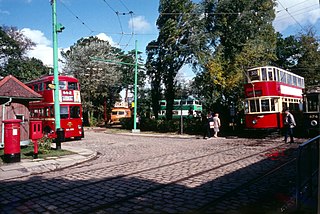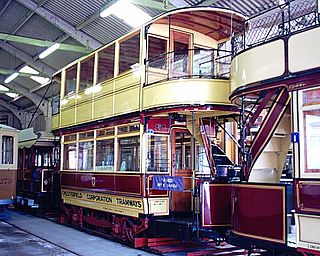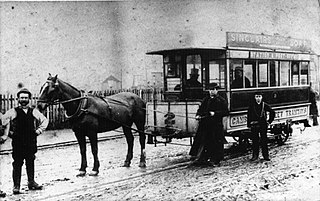
The East Anglia Transport Museum is an open-air transport museum, with numerous historic public transport vehicles. It is located in Carlton Colville a suburb of Lowestoft, Suffolk. It is the only museum in the country where visitors can ride on buses, trams and trolleybuses, as well as a narrow-gauge railway.

The Chesterfield and District Tramways Company and its successors ran a tramway system in the Derbyshire town of Chesterfield, England. The first horse-drawn line opened in 1882, and in 1897, the system was taken over by Chesterfield Corporation, who extended and electrified it in 1904 and 1905. Additional tramcars were purchased, but two had to be scrapped after a disastrous fire at the depot in 1916. The system suffered from a lack of maintenance as a result of reduced staffing levels during the First World War, and the trams were replaced by trolleybuses in 1927.

The Kingston upon Hull tramway network was a network of 4 ft 8+1⁄2 instandard gauge tram lines following the five main roads radially out of the city centre of Kingston upon Hull, East Riding of Yorkshire, England. Two of these lines went west, and two east. The fifth went to the north, and branched to include extra lines serving suburban areas. Additionally a short line linked the city centre to the Corporation Pier where a ferry crossed the Humber Estuary to New Holland, Lincolnshire.

Charles H Roe was a Yorkshire coachbuilding company. It was for most of its life based at Crossgates Carriage Works, in Leeds.
The Mexborough and Swinton Traction Company was the name adopted by the Mexborough & Swinton Tramways Company in 1929 following the introduction of trolleybuses on all its routes. It operated in the West Riding of Yorkshire, England, over routes serving Manvers Main Colliery, Wath upon Dearne and the towns of Rotherham, Rawmarsh, Swinton, Mexborough, Conisbrough and the estate at Conanby.

Belfast Corporation Tramways formerly served the city of Belfast, Northern Ireland.

James Hall Museum of Transport is a transport museum that aims to preserve and promote the history of over 400 years of transport in South Africa in particular, and Africa in general. It is the largest transport museum in Africa. It is located at Pioneers' Park beside the Wemmer Pan in La Rochelle, Johannesburg, South Africa. It was established in 1964 by Jimmie Hall and the City of Johannesburg.

The Rotherham trolleybus system once served the town of Rotherham, West Riding of Yorkshire, England. Opened on 3 October 1912, it was the fourth trolleybus system to be established in the United Kingdom, after the systems in nearby Bradford and Leeds, which had opened simultaneously in 1911, and Dundee earlier in 1912. Between 1912 and 1949, the Rotherham system gradually replaced the Rotherham Tramway.

The Nottingham trolleybus system once served the city of Nottingham, in the county of Nottinghamshire, England. It opened on 10 April 1927, and gradually replaced the Nottingham tramway network.

The Reading trolleybus system served the town of Reading in the English county of Berkshire and was owned by Reading Corporation, which had operated an electric tramway since 1901. As there was a need for major refurbishment of the tramway in the 1930s, they decided to replace it with a trolleybus network. The first route was converted on 18 July 1936, and by mid 1939, trolleybuses were running over most of the tramway routes, with the last tram running on 20 May. By the standards of the various now-defunct trolleybus systems in the United Kingdom, the Reading system was a moderately sized one, with a total of four routes, and a maximum fleet of 63 trolleybuses, a size that lasted from 1 December 1950 to 27 March 1952.

The Walsall trolleybus system once served the town of Walsall, then in Staffordshire, but now in West Midlands, England. Opened on 22 July 1931, it gradually replaced the Walsall Corporation Tramways network.

The Ipswich trolleybus system once served Ipswich, the county town of Suffolk, England. Opened on 2 September 1923, it gradually replaced the Ipswich tramway network.

The Grimsby trolleybus system once served the seaport of Grimsby, in Lincolnshire, England. Opened on 3 October 1926, it gradually replaced part of the Great Grimsby Street Tramways, a tramway that had served both Grimsby and the neighbouring holiday resort of Cleethorpes. It was closed on 4 June 1960.
Southend-on-Sea Corporation Transport was the overarching name given to the local municipal transport services provided to the town of Southend-on-Sea by the local council. Initially started as a tramway, although known officially as Southend-on-Sea Corporation Light Railway, the trams started operating on 19 July 1901 until the service was terminated on 8 April 1942. A trolleybus system was introduced in 16 October 1925, gradually replacing the tramway, before it closed on 28 October 1954. Motorbuses were first run by the Corporation in 1914, but two years later they withdrew the services. Buses did not return to the Corporation's service until 1932, eventually replacing the trams and trolleybuses. In 1974, the organisation was renamed Southend Transport, and after the Transport Act of 1985, it became involved in a bus war with rival Thamesway. The council sold Southend Transport to British Bus group in June 1993, which in turn was taken over by the Cowie group. Cowie was renamed Arriva in August 1998, with Southend Transport becoming Arriva serving Southend.

Cambridge Street Tramways operated a horse-drawn tramway service in Cambridge, England, between 1880 and 1914.

Buses in Ipswich operate in the town of Ipswich in the English county of Suffolk. As of 2013 services are primarily operated by Ipswich Buses and First Norfolk & Suffolk, although other smaller operators, such as Galloway European, Carters Coaches and Beestons, operate routes from the town into the surrounding rural area. Many of the current routes are based on those established at the end of the 19th century when a horse tram network developed.
Bradford Corporation Tramways were a tramway network in the city of Bradford, West Riding of Yorkshire, England which operated trams from 1882 until 1950 and trolleybuses from 1911 until 1972. The track gauge of the tramways was 4 ft.

The Tramway Museum, St Kilda is Australia's principal museum of the 19th and 20th century trams of Adelaide, South Australia. It is situated at St Kilda, 24 kilometres north of the centre of Adelaide. It is operated by the Australian Electric Transport Museum (SA) Inc., a not-for-profit volunteer organisation affiliated with the Council of Tramway Museums of Australasia. It is dedicated to the study, conservation and restoration of trams that were used in Adelaide or built there, and likewise with a small bus and trolleybus collection.Trams provide unlimited free rides for visitors on payment of the entrance fee. They operate along a 1.6 kilometres purpose-built track between the museum and a large adventure playground.
Railless is the generic name for three companies which made trolleybuses in Britain between 1906 and 1926. Railless Electric Traction Co Ltd was established in 1908, and were at the forefront of the introduction of trolleybuses to Britain. Financial difficulties in 1911 resulted in RET Construction Co Ltd being formed, to take over the business, goodwill and patents of Railless Electric Traction. This company ran out of orders during the First World War, and went into receivership. Charles H. Roe took over the bodywork part of the business, using RET's works in Leeds, and the goodwill and patents were sold to Railless Ltd, a new company which had been set up by Short Bros Ltd, and manufacture of the chassis transferred to their Seaplane works at Rochester, Kent.

Beamish Museum contains much of transport interest, and the size of its site makes good internal transportation for visitors and staff purposes a necessity.


















